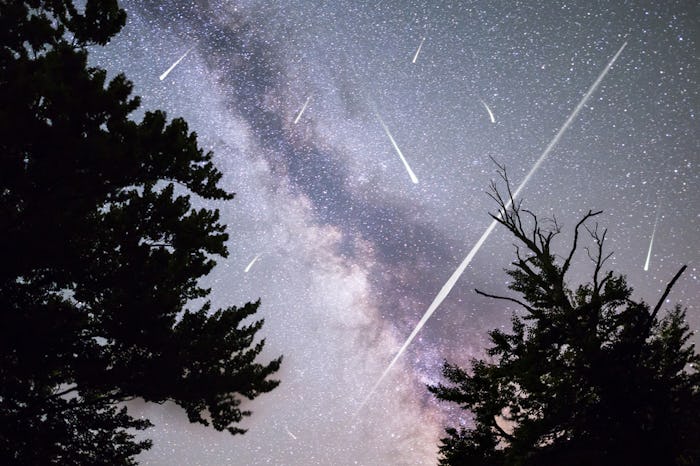News
If You Want To Be Dazzled, Here's When To Look For Shooting Stars & A Full Moon
Solstice comes around twice each year, in the summer and in the winter. Solstice is, traditionally, the celebration of the shortest and longest days of the year. However, this year, in the northern hemisphere, the winter solstice is going to be extra special, because there are two other celestial events happening at the same time. And this is when to watch the last meteor shower and full moon of 2018, because it's all happening at once.
Today — Friday, Dec. 21 — marks the winter solstice, the first day of winter, or the shortest day of the year, according to The Weather Channel. However, this is extra exciting because tomorrow marks December's full moon, as well as the Ursid meteor shower, as The New York Post reported.
If you want to watch the shower up in the sky, The American Meteor Society advises that you may need to be in a location that is low in light pollution. However, they should all be visible in the mid-Northern Hemisphere, given that the full moon's light does not render them harder to see, according to Thrillist.
The AMS also noted that, at peak, you should be able to see about 11 meteors/hour before tomorrow morning, and the meteors should be visible throughout the night, officially starting at 5:23 p.m. EST, according to The New York Post.
The meteors have been named in honor of Ursa Minor, or better known to us — and any other space novices — as The Little Dipper, according to the AMS. Meteor showers are also sometimes referred to "shooting star showers," according to Space.com, which means that you better get all of your 2019 wishes ready.
For those who are interested not only in celestial events, but the history of why solstice is so important — and these coinciding events make this year's advent so exciting — solstices are one of the oldest celebrated traditions in the world.
The Winter Solstice is the day at which the Earth's axis is tilted most far away from the sun, as Forbes reported. However, aside from the scientific perspective, solstice is interesting because cultures around the world have been celebrating it for thousands of years, according to Circlesanctuary.org. "The start of the solar year is a celebration of Light and the rebirth of the Sun. In old Europe, it was known as Yule, from the Norse, Jul, meaning wheel," the site explained.
However, the organization went on to explain that many Western-based cultures have actually pulled some of their holiday traditions from solstice and pagan concepts, like the use of an evergreen tree to signal longevity and ongoing life. The idea behind solstice is to create a celebration of light on the darkest day of the year.
Last, but certainly not least, this month is interesting given that tonight also marks the final full moon of the year. According to Accuweather, the moon is technically referred to as the "Cold Moon," given that, according to the Old Farmer's Almanac, “it is fittingly associated with the month when the winter cold fastens its grip and the nights become long and dark." (You may have heard of October's moon called the Harvest moon, referencing the last big crop harvest before the winter, and so on.)
No matter what you're most excited to see tonight, it's clear that despite technically being the darkest day of the year, it's also the brightest, if you really look. Whether you enjoy the full moon, the celebration of solstice, the official start of winter, or if you're able to catch a few glimpses of the meteors, it's clear that today is totally a perfect kickoff to the holiday season.
Correction: This article has been updated to clarify that two solstices occur every year, in winter and in summer.
After a very frustrating first birth experience, this Deaf mother wanted a change. Will the help of two Deaf doulas give the quality communication and birth experience this mom wants and deserves? Watch Episode Four of Romper's Doula Diaries, Season Two, below, and visit Bustle Digital Group's YouTube page for more episodes.
